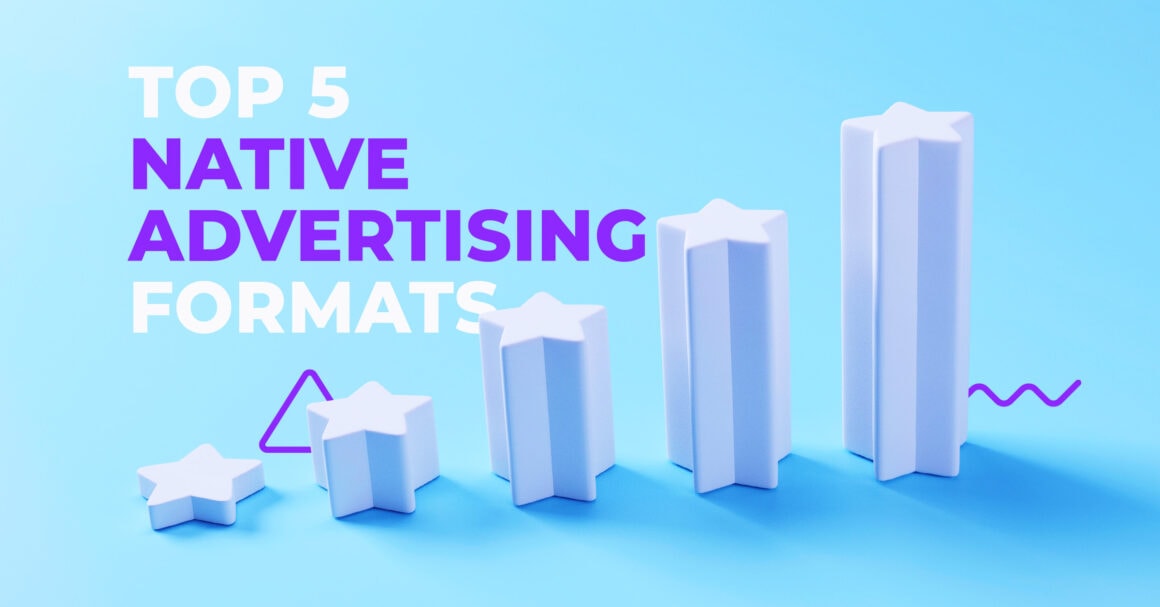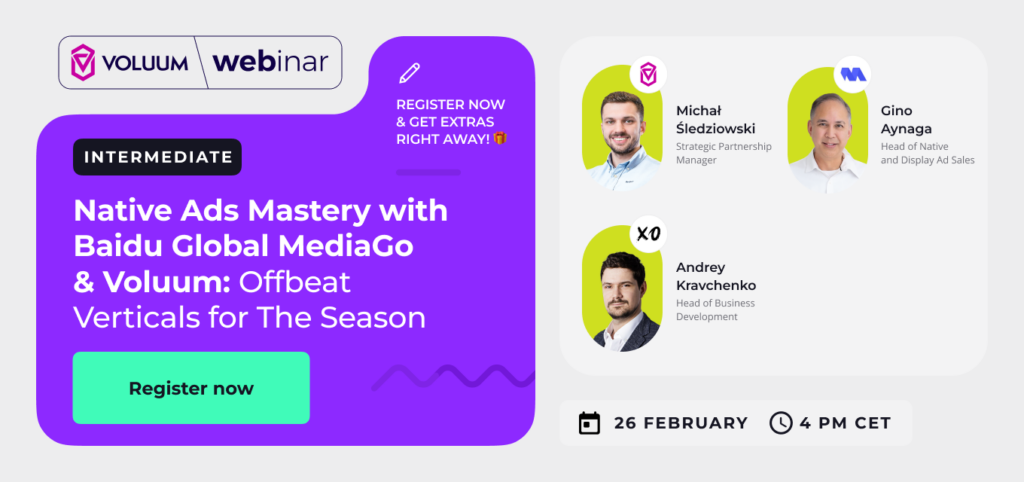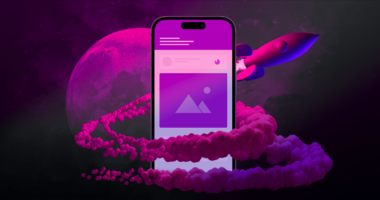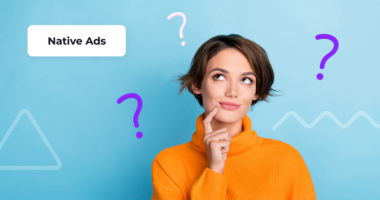No doubt native advertising has cemented its place as an essential part of the modern advertiser’s toolkit. We could even say that native ads are the new black! In this day and age, they are the antidote for brands in need of reach and conversion in a world where consumers try avoiding advertisements. According to Taboola, native advertising spend in 2022 is expected to grow by 36% – it’s been consistently expanding over the last years and already reached $52.75 billion in 2020 which was a huge leap from just $16.68 billion in 2016. Impressive? Let’s check out some more figures!
Native Advertising Statistics
Here are a couple of statistics to help understand how well native ads are doing:
- Native ads are viewed 53% more frequently than display ads.
- Native ads have a 9% higher lift for brand affinity and an 18% higher purchase intent, compared with regular banner ads.
- Over 32% of people would share an interesting native ad with friends, family members or social media followers.
- Close to 90% of younger internet audiences from Gen Z, Millennials and Gen X prefer custom digital content, including native ads, instead of traditional ones.
Native Ads are all around us and you may not even realize it. Unlike traditional ads, this type of digital advertising is designed to match the look and feel of a media source and provide a better user experience. The key to native advertising is that it’s non-disruptive and pretty much exposes the reader to advertising content without sticking out like a sore thumb.
So, How to Spot Native Ads?
As shown by various statistics native ads work. On top of that native advertising done right will most likely look just like all other articles and pieces of content around it. There are a few basic ways web users can identify native ads and all of them include words like Ad, Advertisement, Paid Advertisement, Sponsored Content tagged and highlighted next to the advertised content.
Sounds pretty simple, right? Well, unfortunately it’s not really that easy. Native ads can be quite confusing as they take on a variety of shapes and sizes. Depending on the marketing objectives, brands reach out to different types of content creation for different channels and media placements.
In this handy guide, we’re going to outline the 5 most popular native advertising formats to help you get your creative juices flowing and learn how you can get the most out of your native advertising campaigns. Let’s go through it together!
Types of Programmatic Native Ads
Here are the five most common types of native ads used today and some of their benefits:
- In-Feed Native Ads
This is probably the most popular format of native advertising. You can spot in-feed ads in articles and content feeds. They are created according to the publisher’s requirements in order to harmoniously match the surroundings of the site design. Basically, they don’t disrupt the user experience, but allow readers to view them naturally and with little effort.
The main advantage of in-feed ads is that they are not placed below the article, but within the flow of reading. Based on the research, only 30% of web users will scroll to the end of a page, hence in-feed ads have high visibility and increased brand perception. They not only bring higher CTRs, but also boost conversion rates.
- In-App Native Ads
As stated by Statista, mobile ad spending amounted to $190 billion in 2019 and that figure is expected to increase to more than $280 billion by 2022. In fact, native ads for mobile make up an important part of the app monetization ecosystem. Such ads are non-intrusive and highly-effective, as they mimic the characteristics of an app font, shape, as well as graphic style. They simply blend into the look and feel of the underlying app environment.
Since most users have their mobile phones with them around the clock, apps offer a unique opportunity for marketers to reach them at times when other marketing channels can’t. Plus, as app usage can often be a daily habit, in-app native ads are more likely to engage an already-invested audience. Result? Higher credibility that drives sales.
- Native Content Recommendations
Otherwise known as content Discovery Ads or Content Recommendation Widgets. These are native ads that are typically found below or alongside publisher content, such as an article or in a feed. Content Recommendation Widgets cleverly imitate real referrals from a webpage and get web users to read more without feeling forced. Usually, they are located in blocks labeled as “recommended for you”, “you might have missed” or “from around the web”.
Just think about it for a second. You read an interesting article and discover a notification near the button, revealing: “you also might like”. Doesn’t it look like something you would like to click on? Well, you’re not the only one. Content Recommendation Widgets are definitely more trustworthy than search and social advertising.
- Sponsored Ads
Also called Paid Branded, Sponsored or Custom Content. This ad format is commonly represented by articles, which are created by publishers in partnership with brands. Therefore, the content itself is a part of the native ad buy and can be promoted by In-Feed Ads or Content Recommendation Widgets. You can easily find examples of Sponsored Ads in the New York Times, The Atlantic or other famous news portals.
The Content Marketing Institute reports that 70% of consumers would rather learn about a product or service through content rather than traditional advertising. In fact, when Sponsored ads offer readers useful and empowering information, they build credibility and trust, and at the same time satisfy brands’ long-term goals.
- Native Email Widgets
There is no question that email is one of the best performing channels to distribute content. Native Email Widgets fit seamlessly into the content promoted by the publisher’s newsletters. The powerful combination of valuable, high-quality content delivered by a trusted publisher through a consumer’s favorite digital channel makes native email ads a revenue-driving machine.
Additionally, this ad format eliminates impression waste because the ad is served only when a user opens the email. Not to mention the fact that users can interact with the content in the message, save it, or forward it to friends or relatives. In effect, email Widgets significantly increase the chances of a conversion and have the highest possible ROI.
4 Reasons You Should Add Native Ad Formats to Your Digital Strategy
Draw Attention
Consumers don’t want a sales pitch. They hate it. They’re usually more willing to engage with the ad when they’re not aware someone is trying to sell them something. Unlike annoying, flashy banners and dodgy pop-ups, good native ads integrate perfectly with the rest of the website’s design and act as organic content. Thanks to its undisruptive nature, native offers an excellent way not to irritate your target audience and avoid ad-blocking softwares.
Attract High-Quality Visitors
One of the best benefits of native advertising is that they often pre-qualify potential customers. Since they are shown alongside similar content, web users viewing the ad will most probably have a real interest in the product that you are advertising. For instance, if they are on a fitness website, they most likely would be interested in a native ad that seems like an article about nutrition products and would probably enjoy being redirected to the blog of an online supplements store.
As native ads are woven into educational, emotional, entertaining, or visual content, they have a great potential to go viral. Users typically shy away from sharing content that looks promotional, but when they find it interesting or fun they will happily share it with friends or social media followers. This way, native advertising is giving small businesses a chance to expand the reach and improve brand awareness across different online channels.
Simply Put, It’s Just Effective
Last but definitely not least – native ads result in higher views, increased click-through rates, and greater conversions than almost any display ad. Based on Business Insider study, native ads can have up to 4x higher CTR than non-native ads. Not to mention the fact that generally, users who decide to click on native advertisements spend as much time reading the click-through content as they would on the average publisher site. Sounds good, doesn’t it?
Great ads are not everything
So, while you’re thinking about making your native ads more effective and eye-catching don’t forget that even the best effort could be minimized by the lack of…tracking. Yes, yes, here it goes again. Scaling and improving your campaigns without concrete data could easily result in ads that are not profitable.
But by gathering information like number of conversions and where your customers come from you’ll be able to target your ads better,boost and scale what works or not.
Voluum will let you do all of that and more from one platform. Plus, if you’re using our automation tool, our tracker will take some manual work off your shoulders so you can focus on making money.
Are native ads worth the hype?
Definitely! Native advertising has been shown to be an effective approach to performance marketing. Especially in times when advertisers are trying to overcome banner blindness and ad blocking.
Just don’t make the mistake of running ads before you plan out your goals. By analyzing your business objectives, you can then decide which native ad format best suits your needs and start your native advertising journey.
Voluum is here for you to reach your goals!
No banner with provided ID found



